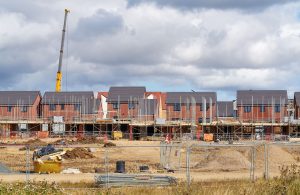
by Hardwick Legal | Nov 22, 2017 | Purpose Built (LexisNexis)

Chancellor of the Exchequer, Philip Hammond delivered his first Autumn Budget on 22 November 2017, after annual Budget announcements moved to publication in Autumn, rather than Spring. The LexisPSL Planning and Construction teams bring together the most important features for the infrastructure and housebuilding sectors.
The full text of the Autumn Budget 2017 is available here.
What are the Budget’s headlines for infrastructure and housebuilding?
Infrastructure
Much was said about existing efforts to invest in infrastructure: Crossrail and HS2 were mentioned as specific examples of how the government is supporting infrastructure growth. New announcements include:
- an increase in the National Productivity Investment Fund from £23bn to £31bn, to support innovation, upgrade infrastructure and underpin the government’s modern Industrial Strategy
- an update to the National Infrastructure and Construction Pipeline in December 2017, setting out a 10 year projection of public and private investment in infrastructure of around £600bn (this update had previously been expected in early 2017, see: LNB News 23/11/2016 87)
- use of the government’s purchasing power to drive adoption of modern methods of construction, such as offsite manufacturing (the Department for Transport, the Department of Health, the Department for Education, the Ministry of Justice, and the Ministry of Defence will adopt a presumption in favour of offsite construction by 2019 across suitable capital programmes)
- a programme for new homes and infrastructure in the Cambridge-Milton Keynes-Oxford corridor. This follows the National Infrastructure Commission’s (NIC) report on this topic published on 17 November 2017 (see: LNB News 20/11/2017 41)
- backing for the Northern Powerhouse and Midlands Engine with a new £1.7bn Transforming Cities fund, half of which be shared by the six areas with elected metro mayors to be spent on delivering local transport priorities, the remainder open for competition by other cities in England
- investing £300m to ensure HS2 infrastructure will accommodate future Northern Powerhouse and Midlands Engine rail improvements
- a new NIC study on the future of freight infrastructure, to be published in spring 2019
- support for electric vehicles in the form of a new £400m charging infrastructure fund, an extra £100m plug-in car grant and an additional £40m for charging research and development
- a new £200m clean air fund funded by additional taxes on diesel cars
- introduction of a VAT domestic reverse charge to prevent VAT losses (following a consultation into options for tackling fraud in construction labour supply chains)
In relation to Crossrail 2, which had not been referred to at all in the Spring Budget this year, the Chancellor said:
The government recognises the need for investment in London’s infrastructure to support its growth, and will continue to work with Transport for London on developing fair and affordable plans for Crossrail 2, including through an independent review of funding and financing.
Housebuilding
The Chancellor identified that the number of young people owning their own homes has dropped from 59% to 38%. He recognised that despite housebuilding standing at its highest rate since the last financial crisis, fixing the housing market will require spending money, planning reforms and intervention. In terms of financial commitments, the government will:
- spend, over the next five years, a total of at least £44bn of capital funding, loans and guarantees to support the housing market and boost the supply of skills, resources and building land and create the financial incentives to deliver at least 300,000 net additional homes a year on average by the mid 2020s
- invest an additional £1.5bn in the Home Building Fund, providing loans specifically targeted at supporting SMEs who cannot access the finance they need to build
- invest £630m in a small sites fund, to pay for infrastructure and remediation to unstick the delivery of small, stalled sites with capacity to deliver 40,000 homes
- invest a further £2.7bn to more than double the housing infrastructure fund
- spend £400m of loan funding for more for estate regeneration to transform run-down neighbourhoods and provide more homes
- commit £1.1bn fund to unlock strategic sites, including new settlements and urban regeneration schemes
- lift Housing Revenue Account borrowing caps for councils in high demand areas, to help them build more social housing—councils will be able to bid for increases in their caps from 2019-20, up to a total of £1bn by the end of 2021-22
- commit £8bn of financial guarantees to support private housebuilding and the private rented sector
- provide an addition £34 m to develop construction skills
- bring together public and private capital to build five new garden towns, using appropriate delivery vehicles such as development corporations, including in areas of high demand such as the South East
Planning reforms were promised. The focus will be on:
- making best use of urban areas where people want to live and most jobs are created. Green belt protections will continue. High quality and high density development in city centres and around major transport hubs will be supported; an announcement for the Secretary of State for Communities and Local Government will set out more detail on how councils in high demand areas will grant more permission for local first time buyers and affordable renters
- closing the gap between the number of planning permissions granted and the number of homes delivered by carrying out an urgent review of the reasons for this. An interim report will be published in spring 2018. If this finds that land is being held back from the market for commercial rather than technical reasons, direct interventions (including through compulsory purchase if necessary) will follow to ensure the incentives change to ensure such land is brought forward for development
- funding and delivering infrastructure to support higher density development, by expanding the Homes and Communities Agency into a new body, called Homes England, which will bring together funding, planning and compulsory purchase powers with a clear remit to facilitate delivery of sufficient new homes where they are most needed to deliver a sustained improvement in affordability
- providing an addition £1.1bn for a new Land Assembly Fund which will enable Homes England to work alongside private developers to develop strategic sites, including new settlements and urban regeneration schemes
- consulting on developer contributions, which will propose: removing restrictions on section 106 pooling, speeding up the process of setting and revising the Community Infrastructure Levy (CIL) to allow authorities to set rates which better reflect the uplift in land values between proposed and existing uses, and changing indexation of CIL rates to house price inflation (rather than build cost)
The government will also support more strategic and zonal planning approaches through housing deals in the South East, where housing need is at its most acute. A housing deal with Oxfordshire has been announced, part of its wider strategic investment in the Cambridge-Milton Keynes-Oxford corridor, where Oxfordshire will bring forward for adoption a joint statutory spatial plan and commit to a target of 100,000 homes by 2031, in return for a package of government support over the next five years, including £30m a year for infrastructure and further support for affordable housing and local capacity.
The government is also continuing housing deal negotiations with Greater Manchester, the West Midlands, Leeds and the West of England.
Additionally, pledges were made to:
- introduce legislation to allow councils to charge a 100% council tax premium on empty properties
- consult on barriers to longer tenancies in the private rented sector, and how landlords can be encouraged to offer longer tenancies to tenants who want the extra security
- invest £28m in three new pilot schemes to reduce homelessness in the West Midlands, Manchester and Liverpool, and establish a new homelessness task force to half rough sleeping by 2022 and eliminate it by 2027
Our overall verdict
Support in terms of spending on critical infrastructure will be widely welcomed and provide confidence that the infrastructure sector is underpinned by government support. Equally positive is the recognition in the Autumn Budget 2017 that infrastructure provision leads to economic growth and regeneration, with a heavy focus on areas outside of London benefitting from investment. Also of interest is the government’s support for the adoption of modern construction techniques (for example offsite construction)—while it falls short of a mandate (as has been the case for the use of building information modelling) for offsite construction, such a move is nonetheless progressive.
The financial commitments to support housebuilding will no doubt be well-received, although as perhaps expected, much of the focus is on building new homes to enable young people to become home owners and there is little other than financial guarantees and a promise to look at longer tenancies for long-term renters and the private rented sector generally. Large house-builders will not welcome the underlying allegations that land-baking is holding back delivery and it is frustrating that a further consultation on CIL is promised, given the wide-ranging CIL Review carried out in 2015/2016. Announcements on planning reform and intervention are also very thin on detail, and while the expansion of the Homes and Communities Agency is a positive move, it already possesses compulsory purchase powers, so it is unclear how it will now be incentivised to use those powers to drive up delivery.
Source: LexisNexis Purpose Built
The Autumn 2017 Budget—infrastructure and housebuilding announcements

by Hardwick Legal | Nov 15, 2017 | Purpose Built (LexisNexis)
 In Gladman v SCLG, the court dismissed a challenge to an inspector’s decision to dismiss plans for up to 330 homes in Kent over air quality concerns, where an adverse effect on an Air Quality Management Area (AQMA) was demonstrated. The inspector had made clear that he understood that the government had to achieve compliance with the Air Quality Directive by the earliest possible date, but was not required to assume that local air quality would improve by any particular amount within any particular timeframe.
In Gladman v SCLG, the court dismissed a challenge to an inspector’s decision to dismiss plans for up to 330 homes in Kent over air quality concerns, where an adverse effect on an Air Quality Management Area (AQMA) was demonstrated. The inspector had made clear that he understood that the government had to achieve compliance with the Air Quality Directive by the earliest possible date, but was not required to assume that local air quality would improve by any particular amount within any particular timeframe.
This Analysis was originally published on Lexis®PSL Planning. Discover how Lexis®PSL can help you stay on top of the latest developments and find the answers you need fast: click here for a free trial to access.
What is the significance of the decision for authorities and developers?
The decision may be useful for local planning authorities, developers and objectors where an adverse effect on an AQMA has been identified.
Whether or not air quality is relevant to a planning decision will depend on the proposed development and its location. Concerns may arise where the development is likely to adversely impact upon the implementation of air quality strategies and action plans and/or lead to a breach of EU legislation, such as the Air Quality Directive 2008/50/EC.
The Gladman case is time-specific, in that the inspector did not know the likely contents of the National Air Quality Plan, which, in future, decision-makers will have to refer to in terms of ensuring that national measures relate to local measures, and what the ‘soonest date possible’ for securing compliance with the Air Quality Directive will be.
It is also worth noting that in this case, the judge considered that the financial contributions to mitigate adverse impacts on air quality ‘had not been shown to translate into actual measures likely to reduce the use of private petrol and diesel vehicles and hence reduce the forecast NO2 emissions’. Therefore if developers propose to use the DEFRA damage-cost model to calculate reasonable contributions to mitigate identified adverse impacts on air quality, they should ensure that such contributions translate into actual measures which reduce NO2 emissions.
What is the factual background to the case?
The claimant, Gladman Developments Ltd, applied pursuant to section 288 of the Town and Country Planning Act 1990 to quash an inspector’s decision in two conjoined appeals against refusals of planning permission for residential development for 330 dwellings plus 60 extra care units.
At the inquiry into those appeals, the inspector agreed with CPRE (Kent), who appeared as a Rule 6 Party, that the appeal should be dismissed due to a failure to mitigate the adverse effects on the designated Newington and Rainham AQMAs.
The claimant had proposed to fund measures to mitigate the adverse impacts of the developments on both AQMAs, whereby contributions were calculated using the DEFRA Emission Factors Toolkit and secured by unilateral undertakings. However, the inspector concluded that there was no evidence of the likely effectiveness of such mitigation measures to reduce NO2 emissions.
What were the grounds of claim?
Among other grounds of challenge, the claimant argued that the inspector erred in:
- failing to understand and apply the outcome of R(Client Earth (No.2)) v SSEFRA [2016] EWHC 2740 (Admin.), that the government had been ordered to produce a plan, at the earliest possible opportunity, which secured compliance with the Air Quality Directive at the earliest possible opportunity and, in any event, before 2020
- failing to give effect to the principle that the planning system presumes that other schemes of regulatory control are legally effective
- failing to explain why application of the DEFRA damage cost analysis and associated contribution was not likely to be effective
- failing to consider the imposition of a Grampian condition requiring a higher contribution to the mitigation fund
Why did the court dismiss the challenge?
Application of Client Earth case
The inspector had made clear in his decision that he understood that the government had to achieve compliance with the Air Quality Directive by the earliest possible date. He was not required to assume that local air quality would improve by any particular amount within any particular timeframe.
It was not known at the time of the inquiry what measures the new draft National Air Quality Plan would contain, let alone what the final version would contain following public consultation. It followed that the inspector did not know how any new national measures would relate to local measures, nor did he know what would be ‘the soonest date possible’ that the new National Air Quality Plan would aim to achieve compliance by. Therefore the inspector could not reach any view as to whether the measures in the new National Air Quality Plan would be likely to be effective in securing compliance by any particular date.
Mr Justice Supperstone concluded that the inspector had properly engaged with the Client Earth (No.2) decision, understood what the case required and formed a judgment as to what the air quality was likely to be in the future on the basis of evidence presented to him. He was entitled to consider the evidence and not simply assume that the UK would soon become compliant with the Directive.
Effectiveness of other schemes of regulatory control
The claimant referred to paragraph 122 of the NPPF in arguing that the inspector had failed to give effect to the principle that the planning system presumes that other schemes of regulatory control are legally effective. Para 122 states that:
‘local planning authorities should focus on whether the development itself is an acceptable use of the land, and the impact of the use, rather than the control of processes or emissions themselves where these are subject to approval under pollution control regimes. Local planning authorities should assume that these regimes will operate effectively. Equally, where a planning decision has been made on a particular development, the planning issues should not be revisited through the permitting regimes operated by pollution control authorities.’
The court held that paragraph 122 of the NPPF was not engaged in the consideration of air quality. Paragraph 122 concerned situations where a polluting process was subject to regulatory control under another regulatory scheme in addition to the planning system and was directed at a situation where there was a parallel system of control, such as in the case of Gateshead MBC v Secretary of State for the Environment [1995] Env LR 37. The planning system should not duplicate those other regulatory controls, but instead assume that they will operate effectively. In this case, there was no separate licensing or permitting decision that would address the specific air quality impacts of the claimant’s proposed development.
Effectiveness of DEFRA damage cost analysis
It was clear from the evidence presented and questions asked by the inspector that the likely effectiveness of the mitigation measures was a live issue at the inquiry. The inspector was required to reach his own judgment on the matter and reached a conclusion that on the evidence he was entitled to reach, explaining what was wrong with the mitigation. The financial contributions had not been shown to translate into actual measures likely to reduce the use of private petrol and diesel vehicles and hence reduce the forecast NO2 emissions.
Consideration of Grampian condition
The court rejected the submissions that the inspector should have considered the use of a Grampian condition when it had not been suggested by the claimant. Inspectors did not have an obligation to ‘cast about for conditions that are not suggested’ to them. The inspector was entitled to take the claimant’s two unilateral undertakings as the claimant’s settled position in respect of mitigation. In addition, in the light of the inspector’s finding as to the lack of evidence as to the effectiveness of the proposed mitigation measures, it was questionable whether such a condition could lawfully have been imposed.
Source: LexisNexis Purpose Built
Court upholds refusal of planning permission over air quality concerns

by Hardwick Legal | Nov 6, 2017 | Purpose Built (LexisNexis)
Th e UN Framework Convention on Climate Change (UNFCCC)’s 23rd Conference of Parties (COP23) begins on 6 November 2017 in Bonn, Germany. This post explores the context, agenda and hopes for COP 23.
e UN Framework Convention on Climate Change (UNFCCC)’s 23rd Conference of Parties (COP23) begins on 6 November 2017 in Bonn, Germany. This post explores the context, agenda and hopes for COP 23.
Context
The United States’ intended withdrawal from the Paris Agreement is the ghost at the feast at COP23, with its formal notice of withdrawal submitted to the UN in August 2017 and resulting fears that this heralds the abdication of American leadership on global climate change efforts. For more on the Paris Agreement, see our previous post: “Between zero and sum” — The Paris Agreement opens for signature.
However, the sense of political urgency ignited during the Paris Agreement talks has not diminished.
COP23 launches amidst a raft of sobering climate change headlines. On the same day as the talks begin, the World Meteorological Organisation (WMO) announced that 2017 is ‘very likely’ to be one of the three hottest years on record, with many of the high-impact extreme weather events over recent months ‘bear[ing] the tell-tale sign of climate change caused by increased greenhouse gas concentrations from human activities.’ Another WMO report detailing a ‘record-breaking’ surge in atmospheric carbon dioxide emissions was published at the end of last month, the day before the UN stated in its annual Emissions Gap report for 2017 that that the gap between the Nationally Determined Contributions (NDCs) and the reductions needed to meet the Paris Agreement pledges were ‘alarmingly high’.
It is clear that COP23 will have to ensure that gap is closed as much as possible.
The role of small island states
The Fijian Prime Minister stated in his opening remarks to COP23 that he brings a ‘collective plea for the world to maintain the course we set in Paris’.
Although being held in Bonn, COP23 is being chaired by Fiji, on behalf of small island states. It is also the first time that a small island state has held this post. Bearing in mind that it was the leaders of small island states during the COP 21 negotiations who urged strongly for a 1.5°C limit to world temperature increases to give their vulnerable lands a chance of survival from warming oceans and rising sea levels, this leadership role is particularly significant.
An agenda of ambition and inclusivity
In his opening remarks, the Fijian Prime Minister was direct about his hopes for COP23:
“We must not fail our people. That means using the next two weeks and the year ahead to do everything we can to make the Paris Agreement work and to advance ambition and support for climate action before 2020.
To meet our commitments in full, not back away from them. And to commit ourselves to the most ambitious target of the Paris Agreement. To cap the global average temperature at 1.5 degrees Celsius over that of the pre-industrial age.”
In order to do so, the agenda for COP 23 is wide-ranging. Time is dedicated for discussion of the Warsaw International Mechanism for Loss and Damage associated with Climate Change Impacts, climate-finance, and capacity building. Mitigation and adaptation remain, again, pressing topics for dialogue and co-operation.
However, money and technology are not the only matters on the table. Gender and climate change is also an official issue for conversation, highlighting the societal impacts of climate change as well as the physical effects.
There will also be a progress check on the Climate Finance Roadmap agreed under the Paris Agreement (the delivery of $100 billion of support by developed countries for developing countries by 2020), and the bringing into force of the Doha Amendment (which establishes the second commitment period under the Kyoto Protocol).
Uniting for the climate
The mood and focus at COP23 is one of getting heads down and getting the job done. The EU has stated that it expects COP23 to demonstrate ‘clear progress on the development of the technical rules and guidelines for implementing the provisions of the Paris Agreement’, echoing the sentiments of the International Emissions Trading Association (IETA). Additionally, the conference itself is leading by example such as taking steps, including by offsetting carbon emissions, to make the conference fully climate neutral.
The potential loss of the United States has spurred Nicaragua, who had previously criticised the Paris Agreement for not going far enough, to formally accede. Although President’s Trump decision was disappointing, it has clearly not fractured the multilateral resolve and momentum that emerged from COP21 to take decisive action against the fundamental causes of climate change, in tandem with respecting climate science. It demonstrates the recognition of the wider international community that climate change is a universal threat, and the importance of putting differences aside in order to uphold and advance the Paris Agreement’s goals.
It also demonstrates one of the key values of COP23: unity for the climate. There needs to be a unity of actors from cities, regions, businesses, investors, the scientific community, and governments. Uniting these groups is necessary to work faster, more closely and more ambitiously to tackle the ever increasing impacts of climate change upon our lands, oceans, ecosystems, planet, and people.
Source: LexisNexis Purpose Built
Uniting for the climate — COP 23 Bonn kicks off







